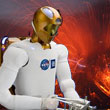 This week in Science Friday, watch the final night launch of the Space Shuttle program, discover a stunning 165-million-year-old spider, tell time more accurately than ever (with lasers!), probe the sun inside and out, and find a really good excuse for missing your boring math class. All this and much more, plus our gadget of the week: Robonaut2.
This week in Science Friday, watch the final night launch of the Space Shuttle program, discover a stunning 165-million-year-old spider, tell time more accurately than ever (with lasers!), probe the sun inside and out, and find a really good excuse for missing your boring math class. All this and much more, plus our gadget of the week: Robonaut2.
Space Shuttle’s Final Night Launch a Success
As the era of the Space Shuttle begins to come to a close, onlookers got a great show Monday at the last ever night launch. On board Endeavor (STS-130) is Cupola, a relatively huge bay window to be attached to the International Space Station (ISS) that will give astronauts the most magnificent view ever seen from space (short of taking a spacewalk). The astronauts will also deliver the most advanced life-support system ever flown into space for recycling wastewater and generating oxygen. More at the official NASA space shuttle website.
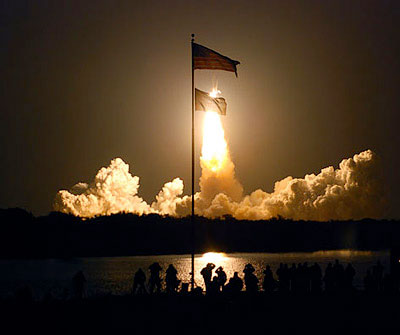
Endeavor, the final night launch for the Space Shuttle program
(Photo: Robert Pearlman)
Stunningly Preserved 165-Million-Year-Old Spider Fossil Discovered
Scientists have unearthed an incredibly well-preserved spider fossil in China, which as been dated to an age of about 165 million years old, part of the Jurassic era. The fossilized spiders, Eoplectreurys gertschi, are older than the only two other specimens known by around 120 million years. The level of detail preserved in the fossils is amazing, said paleontologist Paul Selden of the University of Kansas and lead author of the study appearing Feb. 6 in Naturwissenschaften. “You go in with a microscope, and bingo! It’s fantastic.” Fossils of spiders are very rare because their soft bodies do not preserve well, making this find that much more interesting. See more at WIRED, or read the publication on SpringerLink.


165-Million-year-old spider
Ultra-Precise Quantum-Logic Clock More Accurate than Atomic Clocks
Teams of scientists are racing to build an atomic clock that can replace the current international standard, the cesium fountain clock. The cesium clock loses one second every 100 million years, but Chin-wen Chou of the National Institute of Standards and Technology in Boulder has developed the quantum logic clock, which is 37 times more precise than the international standard. The quantum-logic clock, which detects the energy state of a single aluminum ion, keeps time to within a second every 3.7 billion years. The new timekeeper could one day improve GPS or detect the slowing of time predicted by Einstein’s theory of general relativity. To keep time, quantum-logic clocks measure the vibration frequency of UV lasers, which are anchored to the vibration of an electrically charged aluminum atom. Crazy stuff. Read more at WIRED.
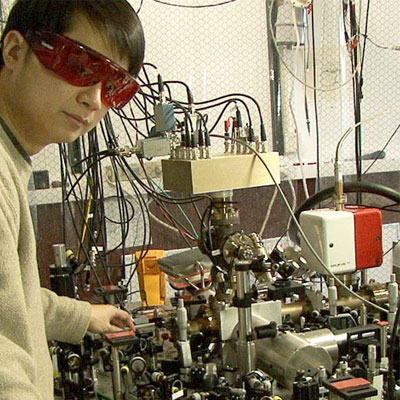
The quantum-logic clock
Satellite Launched to Probe the Sun Inside and Out
Yesterday, NASA launched the Solar Dynamics Observatory (SDO) from Cape Canaveral on an Atlas V rocket. The mission is the first of its kind, as it will study the sun’s inner workings with unprecedented detail. NASA says that SDO will return 150 million bits of data ever second, or about 1.5 terabytes per day. This data stream is so broad, that it will be utilizing a dedicated pair of ground-based 18-meter radio dishes in New Mexico to send back torrents of data. The SDO will help predict solar activity and space weather, and it will study the sun’s interior by watching wave-like movements on its surface with its onboard Helioseismic and Magnetic Imager. Read more at the official NASA SDO website.
You Really Can Be Bored to Death, Study Shows
A boring life may lead to an early death, scientists have discovered. Researchers say that people who complain of boredom are more likely to die young, and that those who experienced ‘high levels’ of tedium are more than two-and-a-half times as likely to die from heart disease or stroke than those satisfied with their lot. More than 7,000 civil servants were studied over 25 years – and those who said they were bored were nearly 40 per cent more likely to have died by the end of study than those who did not. The scientists said this could be a result of those unhappy with their lives turning to such unhealthy habits as smoking or drinking, which would cut their life expectancy. So next time you skip class, tell your professor it was for health reasons.
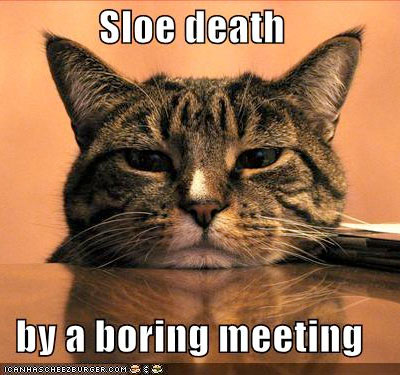
Bored to death!
Picture of the Week: Volcanic Lightning
Did you know that volcanoes can sometimes produce lightning? Pictured below is the Sakurajima volcano in southern Japan, which was caught erupting early last month. Why lightning occurs in volcanoes is something of a mystery amongst scientists. One hypothesis is that the explosive magma and ash particles are themselves electrically charged, and by their motion they create separated areas where a bolt of lightning will arc. Check out the full sized image in all its glory from APOD.
Gadget of the Week: Robonaut2
Engineers from NASA and General Motors have jointly developed what they are calling “the world’s most dextrous robot.” Robonaut2 will be able to assist and supplement human activity in space and in the factory. The robot was built with a human form so that it could work and fit in the same spaces that humans do. The R2, as it is called for short, is being advertised as a human helper robot, but I just hope this thing doesn’t have plans to take over and do all of the work itself. I hear robots will work for cheap.
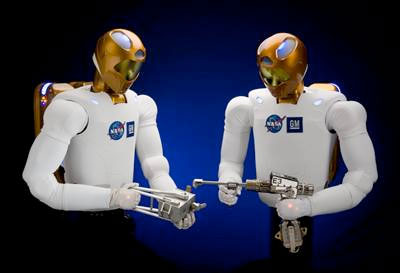
NASA and GM’s Robonaut2
#FollowFriday
If you are on Twitter, you know there are plenty of amazing people out there tweeting away. And, many of them are scientists! Every Friday I’ll be bringing you a new list of great scientists and techies to follow on Twitter. This week…
- @Polar_Gal: Research Assistant at International Arctic Research Center, worked on NABOS expedition in Arctic, love to share passion for poles with kids and the public
- @aprilherbert: Actress who will paint herself blue for money…also might do pointy ears if you’re really nice…
- @Televixen: DVDGeeks’s wonderful and talented Televixen! Actress, writer, TV and radio host, sushi eater, and all-around animal lover extraordinaire.
Science Quickies
Not enough science for you? Here’s a warp-speed look at some more science tid-bits that are worth a look.
- Airborne laser zaps in-flight missile
- New 3D map of interstellar gas around the sun
- Saturn’s most habitable moon offers ice, water, killer views
TrekMovie’s Science Friday is an homage the the great NPR radio show Science Friday. Science Friday® is a registered service mark of ScienceFriday Inc.


What is NASA going to use to lift heavy payloads into when the Space Shuttle is retired?
First Concorde is canceled and now the Space Shuttle, in the search for engineering progress, we appear to be going backwards!
The Space Shuttle has been a great source of pride for the United States. The only re-usable spacecraft in history. Its sad to see it go. Perhaps a future administration will make another shuttle program a priority.
“Yesterday, NASA launched the Solar Dynamics Observatory (SDO) from Cape Canaveral aboard a Saturn V rocket”
A Saturn V, Gracie? Space.com said it was an Atlas V. I think the last Saturn V launched Skylab, a quarter-century or so ago.
– Harry
I love me some science friday! As always, thanks Kayla!
Correction. The last Saturn V launched nearly 37 years ago.
– Harry
3. It was definitely not a Saturn V. I watched it live.
Gah! Awful typo! Thanks for catching that, Harry.
Getting my rockets straight…. stay tuned for correction.
The exploring the Sun article reminded me of this old joke:
A dim-witted scientist is determined to send a probe to the Sun. He calls a press conference to announce his intentions to the world. He tells the throng of reporters that the probe will land on the Sun, take samples, and return to Earth. A reporter asks, “How is that possible? The Sun is far too hot to land on!”
The scientist smiles and says, “Oh, don’t worry, we’re landing at night!”
We nitpick because we care
Why don’t you report the article “Live long and prosper, Xanthoria elegans” by the European Space Agency?
you mean this one: http://www.esa.int/esaCP/SEM72XRJR4G_index_0.html ?
and, if you read in the article, it says brine shrimp can survive the vacuum of space.
Yes.
SEA MONKEYS can survive the vacuum of space!!!
Maybe we can trade Robonaut to the Russians for some rides to the space station once the shuttle flights are terminated.
The USA without a method for putting a man in space.
Pathetic and shameful.
Constellation was NOT just about going to the moon. It was a more reliable and safer system of getting our people and payloads up there.
Thanks to you-know-who, “private Interests” will have to re-invent the wheel and risk lives in the process.
@14.
“Safe” is the wrong way to go. American abhorrence for risk-taking is precisely the thing that’s been hurting the space program for the past 30 years. The space race victory removed America’s impetus to take those risks and so we’ve treaded along the “safe” route for decades – leading to next to no innovation.
Seriously, how many hundreds of space shuttle flights and only two ended in disaster? That’s a far better record than early planes had and yet we treat space travel as if it’s a death trap.
At least Obama’s trying to initiate innovation, even if his plan his probably precisely the wrong way to go about doing it.
That solar satellite clip makes me wanna watch David Boyle’s “Sunshine” again!
Who would win in a fight? NASA & GM’s new robots or Honda’s Asimo? :-)
It’s a shame to see the last night shuttle launch… I think most astronauts would agree that they don’t care about the risk, they wanna keep going up there. And half the reason why the shuttles became dangerous was because environmental laws banned the substances originally used to insulate the shuttle from falling ice.
I just hope I’m still alive to see man’s return to space exploration beyond the ISS. I wasn’t alive to see the original moon missions and I was so excited with the possibilities that Constellation could bring, first back to the moon then possibly Mars…
If we can tighten our belts and save the US and world in general from bankruptcy and restore financial responsibility soon, hopefully we can get manned space back on track without much of a delay.
Ultra-Precise Quantum-Logic Clock
—
Wow, that is incredibly precise. Don’t tell the boss, he will lash it to the punch clock then stand there arms crossed counting the biloseconds of our lunch breaks.
Why is it when I read about the R2 I hear “All Along the Watchtower” in my head?
@18: You’re obviously a cylon.
So it seems that Dr. Elias Giger was correct all along, the human body can indeed get bored to death…
Now all we need is the Soulless Minions of Orthodoxy to be kept at bay long enough for Dr. Giger to complete his Cellular Regeneration and Entertainment Centre!
@19- I’ve been called worse! :)
Another nitpick… the Shuttle is spelled “Endeavour” with a u because it is spelled for one of Captain Cook’s ships and that’s the way the British spelled it.
Note: if STS-134 in July is delayed more than a few days, it will be another night launch (early morning).
1… The Delta IV-Heavy is already capable of launching about as much payload as the Space Shuttle, and an uprated version is coming online in a year or two. But we lose the ability to bring back heavy payloads from space when Shuttle retires. We lose that ability just as we are starting to have a real need for it. Rats.
You know, the space shuttle fleet NEEDS to be retired, but they could build new shuttles…
Being bored to death…that’s scary.
Super ancient spiders, cool!
And volcanic lightning, that’s awesome looking.
Which I could have been there for that night launch.
I actually helped work out some of the theory and mathematics behind the quantum-logic clock. It is always cool to get to see some of your own theoretical physics work put to practical use. I never would have become a physicist if it weren’t for my childhood idolization of Scotty. Everything in the world winds back around to Star Trek.
Oh dear… Im a Civil Servant, in a tedious job.
Frak! I’m going to die… oh well, Vallhalla awaits lmao
16
celebrity deathmatch?
1
some people have been asking for shuttle C
like thats gonna happen
23
thats what the indian oceans for :)
That ancient spider is nothing – I’ve got a yoghurt at the back of my fridge that’s at least twice as old.
29
Yeah? I still have a milk carton with a picture of the missing Lindbergh baby on it!
i love these articles very interesting stuff thnx for taking the time to do these
Jurassic Spider?
Ick…
32 comments and no reference to R2D2?
Shameful. :P
“Houston, we have a problem. This R2 unit has a bad motivator.”
32
arnet they making another one of those movies?
dont give them ideas.
While the R1 model had a head like Boba Fett’s helmet, the R2 looks like a drone from “The Black Hole”.
The “last shuttle night launch” title didn’t last for long. NASA today delayed the next Shuttle launch (STS-131 Discovery) two weeks to April 5. Launch will now be 6:24 am, about 45 mins before sunrise, so another night launch.